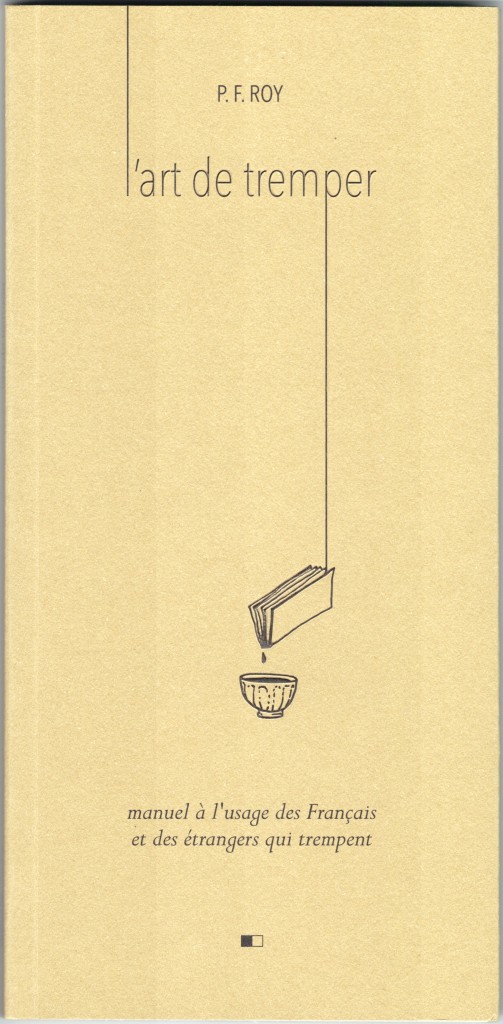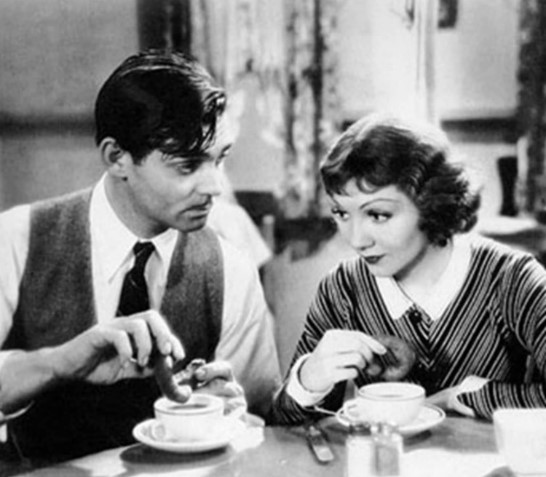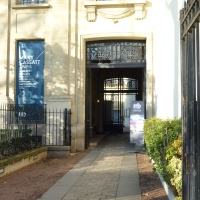Angers. My first term at university in France. Breakfast with my roommate Anne Marie (still a close friend after all these years). She mixed coffee with scalded milk in a bowl, put butter and jam on a piece of baguette sliced lengthwise, dunked it in the café-au-lait, and chewed the result as we tried to make conversation with my still-limited French over the breakfast table. I watched, fascinated, as the crumbs floated on the milky mixture. Whatever fell to the bottom of the bowl she finished with her last mouthful of coffee. As culture shock goes, it was mild, but it gave me something to think about.
I never acquired the habit myself. I even eschewed the bowls (provided by the landlord) for a large mug with a handle (bought with my meagre spending money at the Nouvelles Galeries in Angers), reckoning that those who were accustomed from childhood to drinking hot liquids from bowls probably had hardened fingertips by the time they were of university age. My fingertips were not up to the task.
Things might have turned out differently had I had the benefit of l’art de tremper : manuel à l’usage des Français et des étrangers qui trempent (The art of dunking: A manual for French people and foreigners who dunk) by P. F. (Patrice) Roy (Creaphis Éditions, 2023) to guide me in those days. Patrice recently sent us a copy of his elegantly written book with his own line drawings. It brought back memories of Angers and Anne Marie and my failure to acquire a quintessentially French skill.
And it is a skill or an art, I now realize. The solid ingredients must be sufficiently cohesive to soften without disintegrating in the liquid. The length of time in the liquid must be enough to allow the solids to remain solid while taking on enough liquid to flavour them, but not so long that they fall apart. The moment at which the solid-plus-liquid is conveyed to the mouth must be judged precisely, to avoid disaster.
Patrice’s l’art de tremper not only contains valuable how-to instructions on these and other crucial matters, but provides etymological and historical background on the art and science of trempage. There are footnotes about the origins of pumpernickel bread and the croissant, and the connexions between cups, bowls, and women’s bras. He also includes a mention of a painting in the Musée d’Orsay, one of the few he has found that depicts people dipping food into a liquid.

It is called “Romans during the Decadence” and was painted by Thomas Couture in 1847. The act of “trempage” is occurring in the dead centre of the canvas. How decadent is that?
Patrice was inspired to write the book after a visit to an Irish friend with a Korean wife who has a house in the Eastern Pyrenees. His friend, George, asked what Patrice and his wife Noëlle would like for breakfast. Coffee, in a bowl, they replied. Patrice and Noëlle, as usual, dipped their breakfast pastries into their coffee (their hosts were accustomed to drinking tea for breakfast and eating toast and jam separately). George remarked on the French custom and asked Patrice if anyone had written a book about the practice of dipping solids into liquids. No, said Patrice, and immediately decided to write one.
Patrice, a restoration architect, carefully breaks down the art into its component parts: the receptacle (cup, bowl, or mug), the liquid (coffee, tea, chocolate), the support (usually but not necessarily a baguette), the stabilizer (butter is best), the topping (sweet or savoury), and the assorted props required for effective practice (napkins, tablemats, and a floor mop for novices).
For his part, George contributes a mention of the Dunkin’ Donuts chain in North America, but omits to mention Clark Gable’s role in establishing the practice. In It Happened One Night (1934), Gable taunts the French-born Claudette Colbert, who is dipping her doughnut into her coffee in a leisurely way, “Where did you learn to dunk?” and insists that speed and timing are essential, “A dip…and sock! Into your mouth.” He demonstrates as he speaks.*
Well, that’s one approach. Patrice’s is more measured.
Patrice talks of the Darwinian “missing link” between solid and liquid, between foodstuffs spread out on a table and the interior melting pot of our bodies in which what we eat is inevitably blended. It’s an important point. Norman’s father Wesley, who for a time prepared family meals when his wife Audrey was in hospital, used to dismiss his children’s anxiety about cooking different foods in the same pan by reminding them, “It all goes into the same stomach.”
So why not dip the baguette with butter and jam into the café-au-lait? Why not mop up the sauce with the bread? It’s all going to end up in the same place anyway.
Dipping, dunking, mopping, trempage…the practice takes many forms. The bread topped with cheese on French onion soup, eaten with a spoon. The baguette used to mop up a delicious sauce from a dish of rabbit or lamb while cleaning the plate for the salad course. The North American fondness for salsa on corn chips or for crumbled crackers in soup. And the oh-so-English trifle with ladyfingers soaked in sherry lining a bowl full of custard and fruit. Every national and regional cuisine includes instances of blending solids and liquids.
Early on in the book, Patrice quotes George, who asks if trempage is not considered “low class.” I am not a sociologist, and I cannot possibly comment, but frankly, I don’t care. Norman and I have long since adopted the habit of mopping up our plates with bits of baguette to make the most of the time and effort a chef has spent on creating a lovely sauce. We consider this a mark of respect for the chef.
We are going back to Paris in the next few months. Finally. We have paid the airfare, rented an apartment we have not stayed in before, and made plans to get together with friends. Perhaps this time one of them can teach us the “art de tremper” and we will add to our appreciation of the French way of eating breakfast. And now that one can buy large bowls with handles, we needn’t risk our fingertips.
Text by Philippa Campsie; line drawings by Patrice Roy; Couture painting from Wikimedia; film illustration from The Kitchn blog; bowl with handle and saucer by Gien.
*I cannot resist mentioning here that some fiction writers have interesting ideas about what constitutes breakfast in France. Not long ago, I read a bestselling novel by a young American writer, set in Paris during the Second World War, in which the heroine tucks into a meal of oatmeal and eggs – in wartime! not even powdered eggs! – for breakfast. As I understand it, wartime breakfasts in Paris were skimpy, to say the least. But novelists make their own reality. This is why I prefer non-fiction.



























Well written. I learned something wholly new, and I’ve lived in Paris for over 5 years, and have visited/studied it longer than that.
I loved the It Happened One Night reference. That pulled it all together for me. “Where did you learn to dunk?”
Now I need to know more about the art of trempage. Merci bien!
Delightful ! This brought back so many memories of my first stay in France as an « older student 😉 » when my newly acquired French landlady/friend taught me so much beyond what I learned in class. Je trempe toujours ma baguette grillé .
Fascinating! And now I’m French enough to at least know a new word, though I doubt I’m likely to become a dunker of any sort.
Merci chère Philippa,
pour ce magnifique post. Je le diffuse partout où je peux.
Amitiés islndais caniculaires.
P
>
Dear Philippa and Norman,
I apologize for writing here, as this message is not meant as a comment, so please feel free to delete it afterward. My name is Yara, and I am a writer living in Paris, and I have been reading, loving, and sharing your work for years. Your blog posts have expanded my mind and my world, and shown me so much beauty. Thank you. It is a rare and daunting pleasure to read them.
I am reaching out because you mentioned you are returning to Paris, and since I happen to live here, I would be honoured and delighted if we could meet. A coffee, a walk, a garden, an exhibit you would like to see – I am happy to accommodate your schedule – but I would love the opportunity for a conversation about art and writing and Paris.
If you would like to know who I am before responding (which I completely understand) you may find my bio and books here: http://www.yarazgheib.com You may contact me there or at the email address I am using now (I do not know if you can see it).
I hope to hear from you soon, and even if not, thank you again for your writing. Sincerely, Yara
*- Yara Zgheib * http://www.yarazgheib.com
“I prefer the absurdity of writing poems to the absurdity of not writing poems.” * – Wislawa Szymborska*
I sent a reply to the email address on your website. Thanks for getting in touch and hope to see you soon. P.
Will read and respond immediately! Thank you!
– Yara Zgheib http://www.yarazgheib.com
“I prefer the absurdity of writing poems to the absurdity of not writing poems.” * – Wislawa Szymborska*
Most interesting!!! Love your writings of your experiences!!!
God bless, C-Marie
A new word! And understandings I never realized. My first experience drinking coffee was sneaking out of class Freshman High School year and going to Dunkin’ Donuts. And yes, the plain donuts got dunked, it was all part of the wonderful new experience! I had to only chuckle at Colbert and Gable as they added voices to my high school ritual! Why didn’t I get a Colbert instead of my mate McAfee, if only.
Cheers, great post. Thanks for the smile. And Cheers to Trempage!